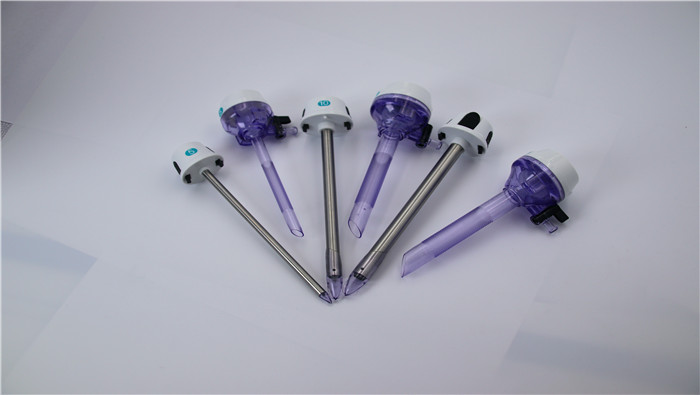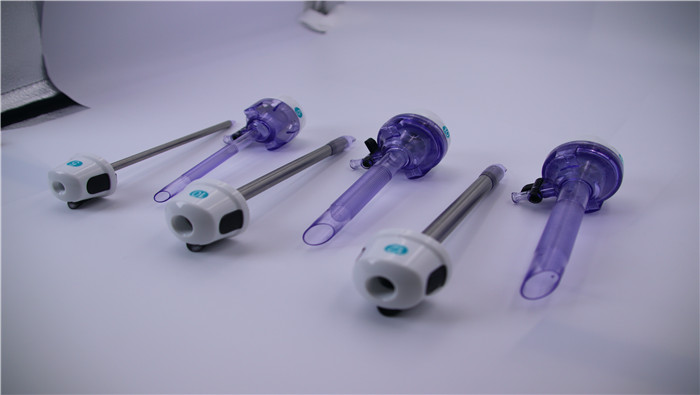

The outer diameter specification of disposable laparoscopic trocars (5mm, 10mm, 12mm) is not set arbitrarily, but is based on the compatibility of the surgical instruments, operational needs, clinical safety and the anatomical characteristics of the patient and other dimensions of the results of a comprehensive consideration. The following is a systematic description of the basis for the division from four levels: clinical needs, instrument suitability, postoperative risk and industry standardization.
I. Clinical Needs and Surgery Type Adaptability
5mm Specifications
Applicable Scenarios: Mainly used for simple operations or auxiliary surgeries, such as grasping forceps, scissors, electric hooks, and other small instrument access in cholecystectomy, as well as minimally invasive surgeries for children or small-sized patients.
Advantages:
Minimized trauma: 5mm puncture hole with mild postoperative pain, fast incision healing, and incisional hernia incidence of less than 1%.
Flexibility: multi-channel layout (e.g., 3-4 puncture points) is possible to meet the need for multi-instrument synergy in complex surgeries.
10mm size
Core use: as the “main operating channel” for laparoscopic surgery, adapting to most standard instruments, such as laparoscopic lenses, ultrasonic scalpels, anastomoses, etc.
Expanded Functions:
Tissue Removal: Small to medium sized specimens such as gallbladder, appendix, etc. can be removed through the 10mm channel;
Energy Instrument Compatibility: High-frequency scalpel, ultrasonic scalpel, etc. need more space to dissipate heat and avoid thermal damage.
12mm specification
Special needs: designed for large caliber instruments, such as linear cutting anastomoses, endoscopic retrieval bags, and some single-port surgical platforms.
Typical surgeries:
Gastrointestinal tumor resection: anastomosis is needed for intestinal reconstruction;
Surgery for obese patients: large thickness of abdominal wall requires more supportive perforators.

II. Instrument Compatibility and Functional Adaptation
Optical System Matching
10mm Lens: Traditional laparoscopic lenses are mostly 10mm in diameter, providing a wider field of view (120°-140°) and higher resolution;
5mm Lens: With the advancement of optical technology, 5mm high-definition lenses are gradually becoming popular, but the luminous flux is still lower than that of 10mm, which is suitable for non-complex surgeries.
Energy instrumentation requirements
Ultrasonic scalpel, bipolar electrocoagulation and other instruments usually have an outer diameter of 5-10mm, but the operation needs to reserve space for heat diffusion, and the 10mm channel can reduce the risk of heat accumulation.
Specimen removal requirements
Organs such as gallbladder and appendix can be removed completely through the 10mm channel, while larger specimens (e.g., intestinal segmental tumors) require a 12mm channel or an enlarged incision.

III.Postoperative Complication Risk Control
Incisional Hernia Probability
Studies have shown that the incisional hernia rate is significantly higher when the diameter of the perforation hole is ≥10mm (about 1%-3% for 10mm and up to 5% for 12mm);
5mm perforation hole is the preferred choice for adjunctive access because of the small fascial defect and virtually no risk of incisional hernia.
Infection and pain management
Smaller hole size (5mm) reduces the risk of intraoperative CO₂ leakage and postoperative subcutaneous emphysema;
10-12mm access is more invasive and requires enhanced suturing techniques (e.g., fascial closures) to minimize complications.
IV.Industry standardization and history
Instrument standardization process
Early laparoscopic instruments had diverse outer diameters (8mm, 11mm, etc.), and in order to reduce hospital purchasing and management costs, the industry gradually standardized on three major sizes of 5/10/12mm;
Normalization of puncture device sizes and mechanical properties by international standards organizations (e.g., ISO) has pushed the convergence of specifications.
Impact of technology iteration
Single-port surgery: spawned larger sizes (e.g., 15mm) of perforators, but limited by penetration rate, 12mm is still the upper limit for multi-port surgery;
Miniaturization trend: the rise of 3mm needle laparoscopy has driven the development of smaller sizes (e.g., 3mm), but has yet to replace the clinical status of 5mm.

V. Patient Anatomical Adaptations
Pediatric and Body Size Differences
Pediatric patients have thin abdominal walls and small cavities, and a 5mm perforator reduces the risk of organ injury;
Obese patients often have abdominal wall thicknesses of >5cm, and require a 12mm perforator to provide adequate channel support.
Special Site Surgery
Pelvic surgery (e.g., gynecology) requires 5mm instruments to minimize collision interference due to narrow space;
Upper abdominal surgery (e.g., hepatectomy) requires a 10mm main channel to ensure visualization and instrument flexibility due to complexity of the operation.
Conclusion
The division of specifications into 5mm, 10mm, and 12mm is essentially a combination of clinical needs, instrument function, risk control, and standardization processes. In the future, with the popularization of single-port/natural lumen surgery, larger or smaller specifications may appear, but the current three major specifications will still dominate the market for a long time. R&D and production need to be closely focused on surgical scenarios to refine the design, for example:
5mm: further lightweight, suitable for robotic surgical instruments;
10mm: integrated intelligent sensing functions (e.g. pressure feedback);
12mm: optimize the sealing structure to reduce the risk of incisional hernia.
By accurately matching clinical needs, the value of minimally invasive can be maximized.
+86 18361958211
marketing@cndonho.com
+86 18361958211
No.2 Zhiwei Road, Qiandeng Town, Kunshan City, Jiangsu Province, China




